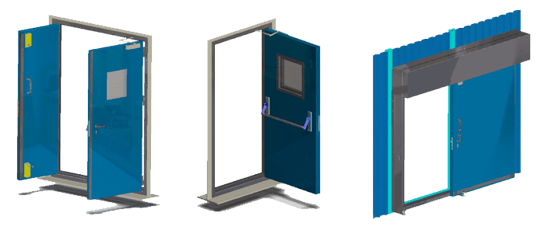
“A” class fire rated doors provide excellent protection against cellulosic fire, which involves materials predominantly existing out of cellulose (e.g. plastics, wood, paper, cotton, textiles). A fire involving these materials is relatively slow growing meaning that the temperature rise is gradually increased to a high intensity.
A60 fire rated doors are used as internal and/or external doors in the oil and & industry and provide protection against cellulosic fires. In this blog the requirements and construction of A60 fire rated doors are outlined.
Cellulosic fire generally remains stable for at least 60 minutes. The standard fire curve of a cellulosic fire reaches 500°C [932°F] within 5 minutes and rises to 945°C [1733°F] over time. Typical radiation value after 5 minutes is 50 kW/m2.
A60 rated doors provide protection for people and equipment against cellulosic fires up to 1 hour. In this way, the fire within an area with A60 rated doors can be contained, allow for safe evacuation and, if necessary, allow time for firefighters to extinguish the fire.
General construction requirements of an A60 fire rated door
A60 fire rated doors are constructed of steel or other equivalent material, are suitably stiffened, and are capable of preventing the passage of smoke and flame to the end of the one-hour standard fire test prescribed in II-2/3.2 of the 1974 SOLAS convention. They are insulated with approved non-combustible materials, such as mineral wool, such that the average temperature of the unexposed side will not rise more than 140°C above the ambient temperature, nor will the temperature at any one point, including any joint, rise more than 180°C above the ambient temperature, within 60 minutes.
A60 doors should also comply with the following requirements in order to pass the integrity test of IMO FTP Code:
- flaming: there shall be no flaming on the unexposed face;
- cotton-wool pad: there shall be no ignition, i.e. flaming or glowing, of the cotton-wool pad when applied;
- gap gauges: it shall not be possible to enter the gap gauges into any opening in the specimen.
Types of A60 fire rated doors

A60 fire rated doors come in all sizes and forms. The most common types are; single hinged, double hinged and sliding doors. It depends on the project requirements which door is the best fit for a certain compartment. All types of doors can be operated manually, electrically or pneumatically.
These doors are suitable to apply in the offshore and onshore oil and gas market, the LNG market and the offshore wind energy market. Single hinged doors can be engineered medium duty and heavy duty. Double hinged and sliding doors are generally only heavy duty because they are often installed as external doors.
All A60 doors are able to withstand blast pressures. The door is engineered in such a way to withstand the equivalent static overpressure as per project requirements.
Want to know more about A60 fire rated doors to protect people and equipment? Download our eBook about fire and blast rated doors now.







